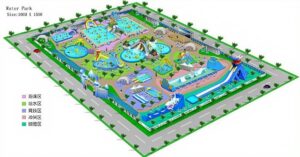
Choosing the right location for an inflatable water park is a crucial step in ensuring the success of your water-based event. Here are some useful tips to help you select the most suitable site.
1. Size of the Venue
The venue should be spacious enough to accommodate all the necessary inflatable structures and the expected number of participants. There should also be ample space for people to move around comfortably. Generally, a venue with an area of at least 1,000 square meters is recommended for large inflatable setups.
---
2. Terrain and Ground Conditions
The ground should be flat and safe for setting up inflatable water park equipment. Uneven terrain can lead to unstable installations and potential accidents. Ensure the surface is level, clean, and free of sharp objects or debris. Soft surfaces like grass or sand are ideal, as they provide a safer landing area.
---
3. Water Supply
A reliable water source is essential for inflatable water parks, as slides, pools, and other water-based attractions require a constant supply of clean water. If the venue does not have a direct water connection, you may need to arrange for large water tanks and ensure the water is clean and safe for use.
---
4. Surrounding Environment
Accessibility: The venue should be easily accessible to participants, with adequate parking facilities and clear signage. Proximity to public transportation is also a plus.
Safety Measures: Check if the venue has safety features such as fences, safety nets, and lifeguards. Emergency rescue personnel should be on-site to handle any unexpected situations.
Ambiance: The surrounding area should be suitable for leisure activities, creating a fun and relaxing atmosphere for visitors.
---
5. Weather Considerations
Wind and Rain: Assess the local weather conditions, especially wind speed and rainfall. Strong winds can destabilize inflatable structures, while rain can make the ground slippery and unsafe.
Sun Protection: If the venue lacks natural shade, consider providing tents or shade structures to protect participants from prolonged sun exposure.
---
6. Legal and Regulatory Compliance
Permits: Ensure you have the necessary permits to use the venue and comply with local regulations for temporary events.
Safety Standards**: Verify that all inflatable equipment meets safety standards and has undergone proper inspections and certifications.
---
7. Layout and Crowd Management
Spacing: Ensure there is enough space between inflatable structures to prevent overcrowding and collisions.
Flow of People: Design clear entry and exit routes to manage the flow of participants efficiently and avoid congestion.
---
8. Hygiene and Cleanliness
Restrooms: Provide sufficient restroom and handwashing facilities, especially for longer events.
Waste Disposal: Place enough trash bins around the venue and arrange for regular cleaning to maintain a tidy environment.
---
9. Emergency Preparedness
-First Aid: Ensure first aid equipment and trained personnel are available on-site to handle emergencies.
Evacuation Plan: Develop and rehearse an evacuation plan to ensure a quick and orderly response in case of an emergency.
---
10. Noise Control
If the venue is near residential or office areas, ensure the event does not generate excessive noise that could disturb the surrounding community.
---
11. Budget Considerations
Venue Costs: Choose a venue that fits within your budget, considering not only rental fees but also additional costs like utilities and cleaning.
Value for Money: Balance cost with the quality and suitability of the venue to ensure a successful event.
---
By carefully considering these factors, you can select a safe, convenient, and enjoyable venue for your inflatable water park. A well-chosen location will not only enhance the participant experience but also contribute to the overall success of your event. Wishing you the best of luck with your inflatable water park project!










